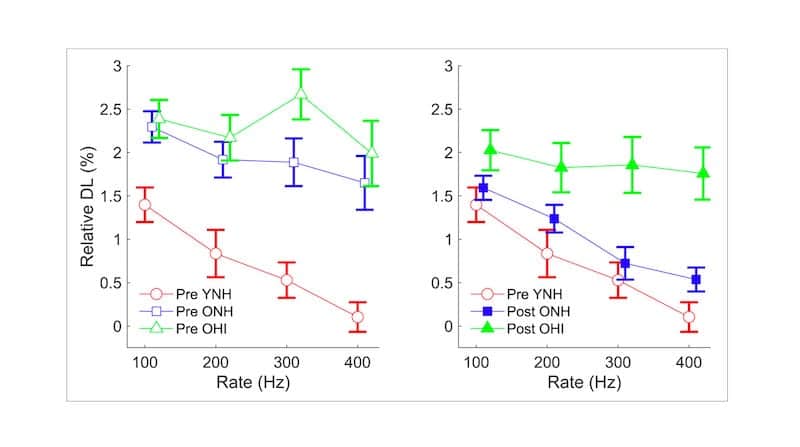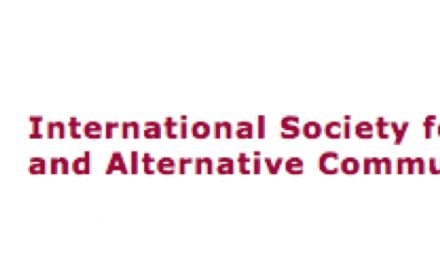Auditory training may partially restore temporal processing.
By Samira Anderson, AuD, PhD
A common complaint among older listeners is that others speak too fast. As we know, raising the volume of our voices distorts speech and often leads to the complaint that we are talking too loudly. Hearing aids improve audibility but do not resolve the problems that older listeners experience when trying to understand rapid speech. A key source of this difficulty is a decline in temporal processing that occurs with aging.(1) This decline has been observed in many behavioral and neurophysiological studies. As a result, older listeners have more difficulty understanding time-compressed and reverberant speech than younger listeners.(2) One source of this difficulty is the reduction of the brain’s ability to precisely encode the neural speech signal.(3-4)
Auditory training has been proposed to improve the ability to understand speech in challenging listening situations, but the results have been mixed.(5-8) Given that speech understanding in older listeners is affected by temporal processing deficits, a program that targets this kind of deficit may be most efficacious for older listeners.
In 2016, the University of Maryland was awarded a Program Project Grant (P01) by the National Institute on Aging to investigate neural plasticity in auditory aging. One of the projects under this grant focused on training to improve temporal processing. The results of their first study, “Rate discrimination training may partially restore temporal processing abilities from age-related deficits,” were recently published in the Journal for Research in Otolaryngology.(9)
Rate Discrimination Training
In this study, three groups of listeners, young normal-hearing (YNH), older normal-hearing (ONH), and older hearing-impaired (OHI), were randomly assigned to an experimental group or an active control group. The experimental group underwent nine sessions of training to improve rate discrimination of band-limited pulse trains centered around two frequencies, 100 Hz and 300 Hz. This training was chosen because it focuses on the ability to process fast changes in rate, a temporal processing ability affected by aging.(10)
Further reading: Johns Hopkins Research Illuminates How the Brain Processes Hearing
The active control group underwent nine training sessions to detect pure tones in wideband noise. The listeners underwent a series of behavioral and electrophysiological tests before and after training. Their rate discrimination ability was tested using four different rates from 100 to 400 Hz, and the brainstem’s accurate encoding of these same stimuli was tested using the auditory steady-state response (ASSR). Generalization to other temporal tasks was tested using non-speech stimuli (gap detection, gap duration discrimination, and tempo discrimination) and speech stimuli (sentences presented in the following conditions: clean, time-compressed (40% and 60%), and reverberant [0.6 ms and 1.2 ms]).
The results showed that although some improvement in rate discrimination occurred in both groups, possibly due to an effect of procedural learning (practice on the task), there was a session × training group interaction due to a larger improvement in performance in the experimental listeners than in the active control listeners. Importantly, the ONH listeners’ performance at the post-test session was not significantly different from the performance of the YNH listeners at the pre-test session (Figure 1). The ASSR also showed improved phase locking to the trained rates (100 and 300 Hz).
Of course, discrimination of pulse trains is not a task that listeners encounter in their daily lives, so it would be important to know if these results are generalized to real-life listening conditions. Nevertheless, the study found that training-related improvements in rate discrimination performance and ASSR phase locking related to improvements in recognizing sentences in reverberant conditions. Therefore, these results suggest that training on a basic temporal processing task may extend to improved speech understanding in everyday life.
Types of Training for Older Listeners
The abovementioned study demonstrated the potential efficacy of targeting temporal processing in an auditory training program. Much more work needs to be done to determine the type of auditory training most suitable for older listeners, whether or not they use hearing aids or cochlear implants. Because of the link between working memory and speech understanding in noise,(11-12) engagement of working memory while listening to speech stimuli may be most effective.
Project 3 of UMD’s P01 grant is currently investigating an adaptive auditory training program that trains the listener to recognize a talker in the presence of a competing talker in familiar scenarios (e.g., restaurant, airport, doctor’s office). Older listeners are randomly assigned to training that requires immediate recall of the sentence (low memory demand) or training the listener to recall the sentence that was one back from what they just heard (high memory demand). The results of this program could guide the development of future auditory training programs.
Training Success
Despite these possible benefits of training, we know that many factors contribute to training success, including intrinsic enjoyment, motivation, and persistence. Poor adherence to the training protocol leads to limited benefits.(13) The same idea applies to fitness training. It is universally accepted that exercise leads to improvements in physical, mental, and cognitive health, yet few people stick to a program, perhaps because they have not yet found one that fits their personality characteristics.
I enjoy interacting with people in my work life, but I am an introvert and hate to participate in an organized fitness class. Solitary running, walking, biking, and weight training work for me. Similarly, an individualized approach to auditory training that considers personality and other factors may improve adherence to training and ultimately lead to the best outcomes.
About the Author: Samira Anderson, AuD, PhD, is an associate professor of Hearing and Speech Sciences at the University of Maryland. After practicing as a clinical audiologist for 26 years, she decided to pursue research to better understand the hearing difficulties experienced by her patients, and she obtained her PhD in December of 2012. Samira’s current research focuses on the effects of aging and hearing loss on central auditory processing and neuroplasticity, and she uses this information to evaluate efficacy of hearing aids, cochlear implants, and auditory training.
Featured image: Figure 1. Relative different limens (DLs, log-transformed) are compared between young normal-hearing (YNH), older normal-hearing (ONH), and older hearing-impaired (OHI) experimental training groups for pre-test data (Panel A) and between pre-test YNH and post ONH and OHI groups (Panel B). The pre-test differences between YNH and ONH groups were not present at post-test, but differences persisted for the OHI groups. Errors bars: ± 1 S.E
This article was originally published in Canadian Audiologist, Vol. 10, Issue 1, 2023.
References
- Schneider B, Pichora-Fuller MK. Age-Related Changes in Temporal Processing: Implications for Speech Perception.Sem. Hear. 2001;22, 227-240.
- Gordon-Salant S, Fitzgibbons PJ. Temporal factors and speech recognition performance in young and elderly listeners. J Speech Hear Res. 1993;36(6):1276-1285. doi:10.1044/jshr.3606.1276
- McClaskey CM, Dias JW, Harris KC. Sustained envelope periodicity representations are associated with speech-in-noise performance in difficult listening conditions for younger and older adults. J Neurophysiol. 2019;122(4):1685-1696. doi:10.1152/ jn.00845.2018
- Roque L, Gaskins C, Gordon-Salant S, Goupell MJ, Anderson S. Age Effects on Neural Representation and Perception of Silence Duration Cues in Speech. J Speech Lang Hear Res. 2019;62(4S):1099-1116. doi:10.1044/2018_JSLHR-H-ASCC7-18-0076
- Anderson S, White-Schwoch T, Parbery-Clark A, Kraus N. Reversal of age-related neural timing delays with training. Proc Natl Acad Sci USA. 2013;110(11):4357-4362. doi:10.1073/ pnas.1213555110
- Ferguson MA, Henshaw H. Auditory training can improve working memory, attention, and communication in adverse conditions for adults with hearing loss. Front Psychol. 2015;6:556. Published 2015 May 28. doi:10.3389/fpsyg.2015.00556
- Karawani H, Bitan T, Attias J, Banai K. Auditory Perceptual Learning in Adults with and without Age-Related Hearing Loss. Front Psychol. 2016;6:2066. Published 2016 Feb 3. doi:10.3389/fpsyg.2015.02066
- Saunders GH, Smith SL, Chisolm TH, Frederick MT, McArdle RA, Wilson RH. A Randomized Control Trial: Supplementing Hearing Aid Use with Listening and Communication Enhancement (LACE) Auditory Training. Ear Hear. 2016;37(4):381-396. doi:10.1097/ AUD.0000000000000283
- Anderson S, DeVries L, Smith E, Goupell MJ, Gordon-Salant S. Rate Discrimination Training May Partially Restore Temporal Processing Abilities from Age-Related Deficits. J Assoc Res Otolaryngol. 2022;23(6):771-786. doi:10.1007/s10162-022-00859-x
- Anderson S, DeVries L, Smith E, Goupell MJ, Gordon-Salant S. Rate Discrimination Training May Partially Restore Temporal Processing Abilities from Age-Related Deficits. J Assoc Res Otolaryngol. 2022;23(6):771-786. doi:10.1007/s10162-022-00859-x
- Gordon-Salant S, Cole SS. Effects of Age and Working Memory Capacity on Speech Recognition Performance in Noise Among Listeners With Normal Hearing. Ear Hear. 2016;37(5):593-602. doi:10.1097/ AUD.0000000000000316
- Pichora-Fuller MK, Schneider BA, Daneman M. How young and old adults listen to and remember speech in noise. J Acoust Soc Am. 1995;97(1):593-608. doi:10.1121/1.412282
- Saunders GH, Frederick MT, Arnold ML, Silverman SC, Chisolm TH, Myers PJ. A Randomized Controlled Trial to Evaluate Approaches to Auditory Rehabilitation for Blast-Exposed Veterans with Normal or Near-Normal Hearing Who Report Hearing Problems in Difficult Listening Situations. J Am Acad Audiol. 2018;29(1):44-62. doi:10.3766/jaaa.16143




